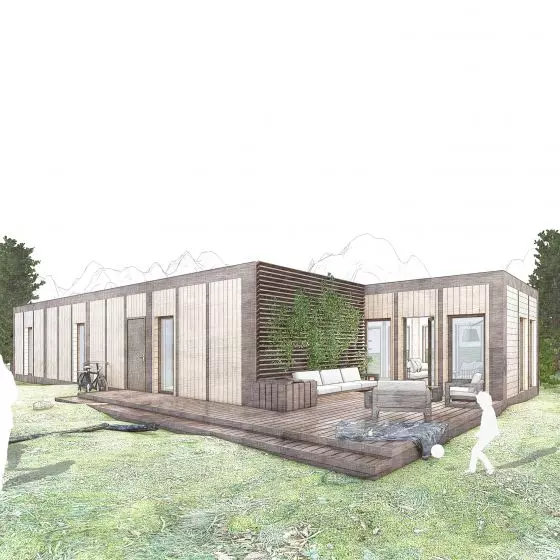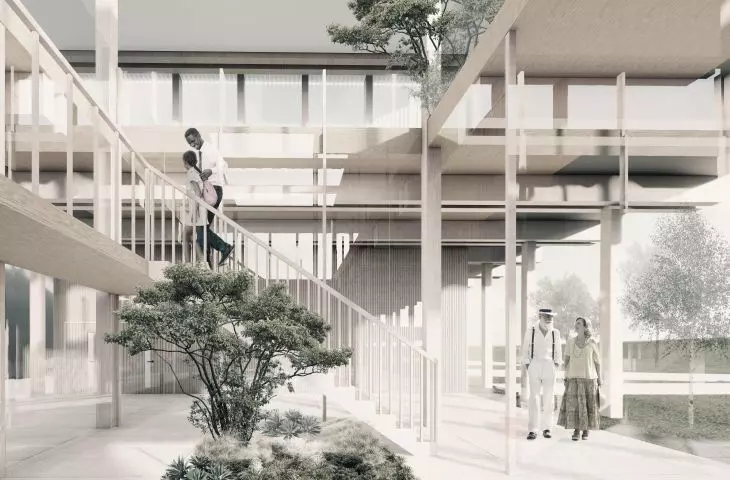The Invisible Hub international competition to design a community center in Vancouver organized by Arc Ace was full of successes for Polish female architects. The {tag:studenci}, a graduate of the Faculty of Architecture at the Silesian University of Technology, proposed a green building made of wood construction that can be easily dismantled and used elsewhere, and took fifth place !
HUB project received fifth prize
© Martyna Kotulek
The goal of the project was to create a community center in Vancouver, the facility would operate in the form of a HUB, i.e. a multi-purpose building connecting the local community. It would provide a place where art and nature intermingle with social functions. The competition objectives were: social integration, connecting the user with nature, connecting architecture with nature, creating lively social spaces, and connecting the building with the existing heights of the site. The organizers paid attention to the creation of green platforms-floors integrated with public spaces, the use of natural materials, the creation of a place where art will bring together representatives of different social groups. An easily accessible place that everyone can visit. It was important to balance the public outdoor spaces with the spaces inside the facility.
The center is a meeting place for the Vancouver community
© Martyna Kotulek
successes of Polish women!
Of the works submitted for the competition, the jury awarded five, and among them were as many as three projects from Poland! First Prize went to Weronika Deszkiewicz from Poznan University of Technology, second place went to the team composed of: Nastaran Houshmand Khaligh and Seyyed Amirreza Bahrololoumi Tabatabaee from Iran. Third prize went to Karolina Kaczor from the Silesian University of Technology, fourth prize went to Rashi Karkoon and Smriti Sharma from India, and fifth prize went to Martyna Kotulek for her Community HUB project.
According to the definition, a community HUB is a multifunctional center that provides a wide range of high-quality services to the local community, with the option to create space for new services - in response to the changing needs of society. The local community is involved in decisions about how the facility is managed. The pluses of such facilities, is not only to meet the needs of the community, but also to build more close-knit and close-knit social ties in urban spaces. The Community HUB is an extremely valuable idea in Vancouver, given the city's diverse population. Immigration has increased significantly since the 1980s, making the city more ethnically and linguistically diverse. 53% of Vancouver residents do not speak English, while nearly 30% of the city's residents are of Chinese descent. As a very culturally diverse city, it could be said that Vancouver needs a place that unites culturally diverse individuals, a place with a wide range of possibilities, says Martyna Kotulek.
The structure of the building was made of wood
© Martyna Kotulek
False Flat Creek's industrial history
The project site is located in the False Flat Creek neighborhood, which was a mud flat until the early 20th century. As the city's industrial activity began to expand, the district began to be filled in and by 1919 both the Great Northern Railway (GNR) and the Canadian Northern Railway (GNR) had established their new western, terminus there.
The size of the lots and roads that were eventually created reflected the chaos and speed of their delineation, which remains evident today and is a great contrast to the care and rigor that characterizes other parts of Vancouver. Currently, the city is planning to establish a creative campus in the district, the author adds.
masterplan of the establishment
© Martyna Kotulek
meeting place
Martyna Kotulek's idea was to design a premise that is shaped around the main public space - a meeting place for the local community. The form of the building entirely derives from the shaped public spaces and pedestrian communication envisaged in the area, and the way of shaping the object was inspired by the composition layout of the city.
The object that the author proposed, like the neighborhood in which it is located, breaks out of the orthogonal grid characteristic of the city, imitating the slant of the plot. On the other hand, the internal layout of communications along with the main public space are elements based on the orthogonal grid. The functional-spatial program of the premise includes the integrity of the urban spaces with the internal spaces of the building, as well as their interpenetration with the existing urban fabric.
Community HUB project, atrium
© Martyna Kotulek
The functions envisaged by the project fall into five categories: artistic, social, commercial, sports and café. Their location on the plot is determined by the external conditions of the site. Exhibition spaces, as well as sports spaces, are located on the side of the university buildings, i.e. the east. The lobby along with retail outlets are located from the entrance to the plot (west). The café, on the other hand, is envisioned on the south side. Social spaces surround the building's inner atrium, providing the opportunity to move activities outside the building. The atrium provides a public space where the local community meets, a place that supports smaller ethnic groups and diversity.
functional and structural scheme
© Martyna Kotulek
building adaptable to change
The building is designed in the spirit of sustainability - the author introduced a high number of biologically active areas - green roofs (with the function of additional public space), retention basins and rain gardens.
In the context of the plans for this city district, as well as the projected rise in sea level, and optional earthquakes, I assumed a design adaptable to change. I proposed a lightweight, wooden structure that could easily be dismantled later, reused elsewhere, and the HUB would then take the form of a temporary installation providing a place for local community integration," Martyna Kotulek concludes.

















































